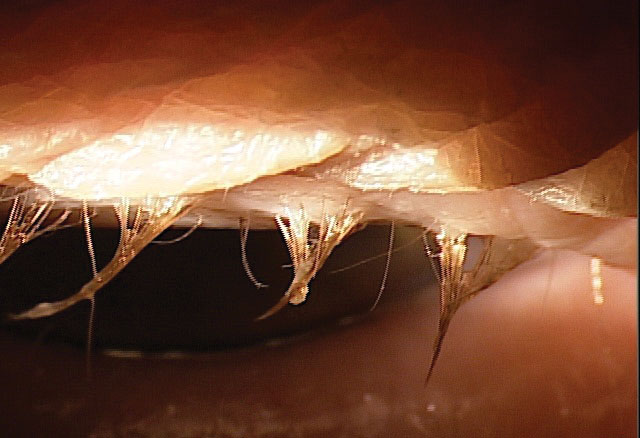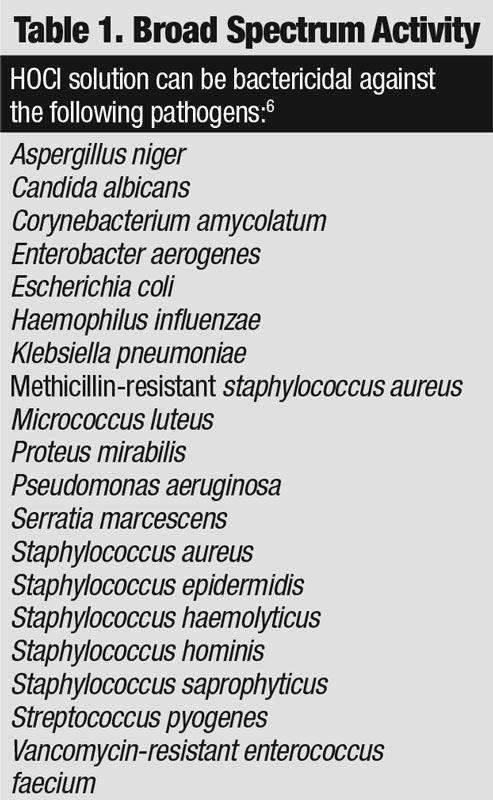 |
Hypochlorous acid (HOCl) has a multitude of uses in wound care, dermatology, dentistry and eye care. It is the most common disinfectant in medical, industrial and domestic use, and has the same active ingredient of household bleach but with a different chemical structure.1 Bleach, or sodium hypochlorite, is typically found in concentrations that range from 1% to 5%, which would result in chemical burns to the eye upon contact. HOCl, however, is found in much lower concentrations and has no such risks.
HOCl is an appealing disinfectant because it is an all-natural antimicrobial agent. Pure HOCl is produced as an element of the human immune response.2,3 During the oxidative burst, small, highly reactive molecules such as HOCl are generated as white blood cells respond to pathogens in the body.2,4 HOCl is released by neutrophils to kill microorganisms and neutralize toxins released from pathogens and inflammatory mediators.5
Because it is neutralized quickly, HA is nontoxic to the ocular surface.5
 |
| Hypochlorous acid is a natural, gentle way to eradicate bacteria on and around the eyelids. |
Gentle But Effective
Although HOCl is natural, it’s surprisingly potent. It has broad-spectrum antimicrobial activity and can kill microorganisms rapidly (Table 1).6 HOCl is highly effective in vitro against a wide range of microorganisms, helping to fight infection, reduce inflammation, control the body’s response to injury and enhance its natural ability to heal.
In eye care, HOCl can provide effective relief from dry eyes and hordeola. It’s a treatment option for red, itchy eyelids associated with conditions such as blepharitis and meibomian gland dysfunction (MGD). Lid hygiene products containing HOCl are an excellent addition to a patient’s daily wellness routine to decrease the microbial load on the lids and lashes.7
Surfactant cleaners are often a necessary long-term therapy, but HOCl is also a safe daily use option, as it is unlikely to cause skin irritation associated with other cleaners and scrubs containing preservatives or other additives. HOCl is also an excellent choice following in-office blepharoexfoliation because it can prolong wellness after bacterial load de-bulking.
For patients with MGD, HOCl is well paired with warm moist compress therapy to provide the dual effect of reducing the bacterial burden and promoting secretions.
We can also use HOCl as preoperative antisepsis, to clean instruments such as tonometry tips, and following a short course of a topical antibiotic-corticosteroid to keep the bacterial levels at bay.8,9
Surfactants and HOCl: A One-Two PunchWhile HOCl may be beneficial in severe conditions, many patients still need to use surfactant cleaners. The root cause of anterior blepharitis is the overproduction of oils, which harbor bacteria that cause eyelid inflammation. The key to reducing this bacteria flora is to first remove the excessive oils from the eyelids and then follow up with antimicrobials. Mild surfactants in several eyelid cleansers act to dissolve and remove oil, debris and desquamated skin. HOCl formulas do not contain these surfactants and are largely ineffective in debriding the oil, scales and debris often associated with eyelid irritation. Accordingly, in the most severe cases where HOCl might be most beneficial, clinicians should recommend a combination therapy including both a surfactant cleanser and HOCl to achieve the best outcomes for the patient. |
Protect the Microbiome, Prevent Resistance
Our bodies are home to a diverse microbiome, and eyes are no exception. Some bacteria, fungi and viruses may protect against harmful pathogens, and full eradication is rarely beneficial.10 Thus, we often aim to simply reduce the overall bacterial load.
Studies show that blepharitis patients, for example, harbor a bacterial load more than 14 times greater than controls, and a HOCl solution may help reduce the number without strengthening harmful strains.2,11
Researchers also discovered that HOCl decreased the bacterial load by more than 90% without significantly altering the diversity of the bacterial species.2 In addition, products containing HOCl generally are not antibiotics and do not contribute to the ever-growing issue of antibiotic resistance.7,12,13
 |
Pick the Right Product
Four factors are important when differentiating HOCl solutions: purity, preservation, pH and prescription.
Purity. Many HOCl products contain ingredients, such as bleach byproducts and other chemicals, you may not want patients encountering on a daily basis. For long-term use, look for solution free of additives, fragrance, chemicals or other byproducts. All HOCl formulations are safe regardless of the purity level. Without the sodium hypochlorite (NaOCl) balance, the equilibrium shifts and the pure products are unstable.
Preservation. The stability of HOCl solutions is generally quite limited. Although HOCl may have a shelf life of years, once a bottle is opened, the product begins to degrade. If your patient uses the solution only occasionally, a brand with a longer shelf life may be important to maximize efficacy and avoid waste.
pH. The properties of HOCl in solution depend strongly on the solution’s pH.14 For patients with pruritis, for example, HOCl can either decrease or promote the condition, depending on the product’s pH.14 Research shows that a pH of 3.5 to 5 is necessary to maintain a stable HOCl solution, maximize its antimicrobial activities and minimize undesirable degrading products.6
When pH is less than 3.5, the solution exists as a mixture of chlorine.6 When pH is higher than 5.5, NaOCl starts to form and becomes the predominant species in the alkaline pH.6
Prescription. While in the past optometrists needed to write a prescription for most HOCl solutions marketed for ocular use, several over-the-counter (OTC) options exist today. This is not due to an FDA decision to reclassify HOCl. Instead, the prescription-only availability of specific HOCl solutions is a manufacturer prerogative that generally allows for more specific claims about a product. OTC HOCl solutions can have the same concentration of active ingredient, but marketing statements are typically more general. Several formulations are now available and marketing in eye care, including:
• Avenova (NovaBay). This prescription spray contains pure HOCl and is designed to remove microorganisms and debris on and around the eyelid margins.
• HypoChlor (OcuSoft). This 0.02% concentration of HOCl, available without a prescription in both spray and gel formulations, is stable opened or unopened for 18 months.
• Bruder Hygienic Eyelid Solution. This 0.02% pure HOCl solution is available OTC and may be a beneficial addition to a daily eye care regimen for patients with mild or moderate conditions.
• Sterilid Antimicrobial (Akorn). This OTC spray is 0.01% HOCl with a 24-month shelf life open or unopened.
• HyClear (Contamac). Stable for up to 18 months after opening, this product contains 0.01% HOCl and is available only through ophthalmology or optometry practices.
• Zenoptiq Hypochlorous Acid Solution (Focus Laboratories). Available without a prescription, this spray maintains stability for 18 months after opening. Ingredients include 99.94% electrolyzed oxygenated water, 0.048% sodium chloride, 0.01% HOCl and 0.002% NaOCl.
Because reducing the bacterial load is a useful tool for blepharitis, MGD and dry eye, more clinicians are turning to HOCl—particularly now that so many choices are available OTC or in doctors’ offices.
Note: Dr. Karpecki consults for companies with products and services relevant to this topic.
| 1. Gray MJ, Wholey WY, Jakob U. Bacterial responses to reactive chlorine species. Annu Rev Microbiol. 2013;67:141-60. 2. Stroman DW, Mintun K, Epstein AB, et al. Reduction in bacterial load using hypochlorous acid hygiene solution on ocular skin. Clin Ophthalmol. 2017;11:707-14. 3. Hurst JK. What really happens in the neutrophil phagosome? Free Radic Biol Med. 2012;53(3):508-20. 4. Kumar V, Abbas AK, Fausto N. Acute and chronic inflammation. In: Robbins and Cotran Pathologic Basis of Disease. 7th ed. Philadelphia: Elsevier; 2005:29-73. 5. Sindt C. Wash away your old hygiene strategy. Rev Cornea Contact Lens. 2014;151(4):7. 6. Wang L, Bassiri M, Najafi R, et al. Hypochlorous acid as a potential wound care agent: part I. Stabilized hypochlorous acid: a component of the inorganic armamentarium of innate immunity. J Burns Wounds. 2007;6:e5. 7. Harsch AG, Stout N, Lighthizer N. Beat the blepharitis blues. Rev Cornea Contact Lens. 2016;153(7):12-15. 8. Dang V. Sizing up anti-inflammatories in dry eye disease. Rev Optom. 2018;155(4):62-65. 9. Romanowski E, Stella N, Yates K, et al. In vitro evaluation of a hypochlorous acid hygiene solution on established biofilms. Eye Contact Lens. 2018 Nov;44(Suppl 2):S187-S191. 10. Lina G, Boutite F, Tristan A, et al. Bacterial competition for human nasal cavity colonization: role of Staphylococcal agr alleles. Appl Environ Microbiol. 2003;69(1):18-23. 11. Bezza Benkaouha I, Le Brun C, Pisella PJ, et al. Bacterial flora in blepharitis. J Fr Ophtalmol. 2015;38(8):723-28. 12. Ono T, Yamashita K, Murayama T, Sato T. Microbicidal effect of weak acid hypochlorous solution on various microorganisms. Biocontrol Science. 2012;17(3):129-33. 13. Debabov D, Noorbakhsh C, Wang L, et al. Avenova with Neutrox (pure 0.01% HOCl) compared with OTC product (0.02% HA). NovaBay Pharmaceuticals:1-5. 14. Pelgrift RY, Friedman AJ. Topical hypochlorous acid (HOCl) as a potential treatment of pruritus. Curr Derm Rep. 2013;2:181. |

